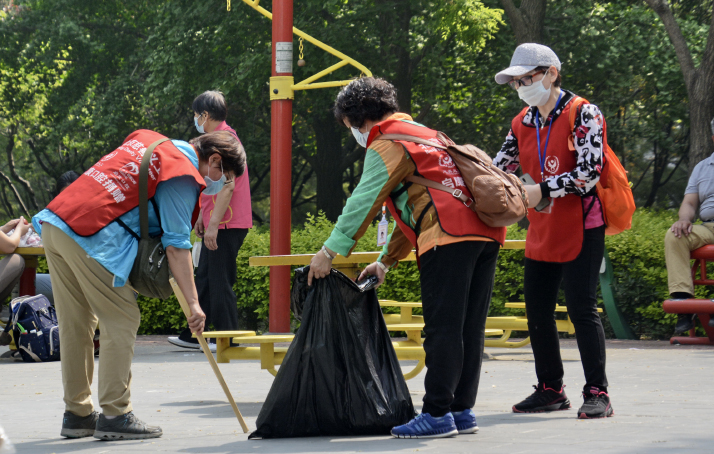|
||||||
|
||||||
| Home Nation World Business Opinion Lifestyle China Focus ChinAfrica Video Multimedia Columnists Documents Special Reports |
|
||||||
|
||||||
| Home Nation World Business Opinion Lifestyle China Focus ChinAfrica Video Multimedia Columnists Documents Special Reports |
| Nation |
| Charity faces opportunities availed by new technology |
| By Ji Jing · 2020-09-25 · Source: NO.40 OCTOBER 1, 2020 |
 Volunteers collect garbage and disinfect recreational facilities at Lianhuachi Park in Beijing on May 1 (XINHUA)
At the 99 Giving Day, an annual charity event held on September 9, donations poured in from Internet users, enterprises and the Tencent Charity Foundation of technology company Tencent. They totaled more than 3 billion yuan ($443 million), marking a new high in the cause of charity in China. On that day, various charitable activities were held across the country. Many charities live-streamed their projects on various social media platforms while viewers donated during the live shows. The Changchun XinYu Volunteer Association in Jilin Province in northeast China received funding from several charitable foundations. The association engages volunteers from local universities to raise funds for disabled children and children from poor households and offer them tutoring services and psychological counseling. Launched in 2015 by Tencent, together with other organizations and celebrities, 99 Giving Day demonstrates the power of technology to help vulnerable groups. Tencent leverages technologies to enable the digitalization of charitable activities. The digitalization of charitable activities is a new trend mentioned in the Blue Book of Philanthropy: Annual Report on China's Philanthropy Development released by the Chinese Academy of Social Sciences, the Social Sciences Academic Press and the China Lingshan Council for the Promotion of Philanthropy on July 26. The report pointed out new trends as well as opportunities and challenges facing charities in China.  Children learn to make craft articles at the Qilu Children's Hospital in Jinan, Shandong Province in east China, on May 29. The lessons are given under the New Sunshine Wards charity project (XINHUA)
New trends An increasing number of charity organizations are seeking to solve social problems with science and technology, while technology firms are providing technical solutions. On September 5, at another annual charity event, the 95 Charity Week, launched by e-commerce giant Alibaba and others in 2017, famous actress Ma Yili said her experience of doing charitable work made her realize the importance of using science and technology in the work. To help a child whose family couldn't afford a surgery, she once raised money by talking to her friends one by one to persuade them to donate. However, she later realized this approach was not only time- and energy-consuming but also unsustainable. When she became the ambassador of China Social Welfare Foundation's charity program Free Lunch for Children, she learnt that people can donate through Alipay, an online payment platform of fintech firm Ant Financial, or Weibo, a social networking platform. "Anyone can take part in charity anywhere, anytime," she said. Since the free lunch project was started, 95 percent of donations have come from ordinary Internet users. The Internet has also helped the project to be more transparent. Schools that benefit from the project are required to post photos of children having lunch on Weibo every day. Luo Yuping, a student from the Miao ethnic group in Chengbu County, Hunan Province in central China, saw her college dream come true with help from Ant Financial. Under a charity plan of the company, when users make transactions through Alipay, a tiny portion will go into charity. Through the program, Luo received 6,000 yuan ($880) during her high school years, coming from more than 70,000 persons who made online payments. Now a student in the University of International Business and Economics in Beijing, she expressed her gratitude to her helpers at a recent charity forum. Ant Financial has used blockchain technology to make money transactions traceable. Blockchain technology was also used for this year's 99 Giving Day event. "In the post-pandemic age… the charity ecosystem will face more opportunities and challenges," said Charles Chen, co-founder of Tencent and founder of Tencent Charity Foundation at the opening ceremony of this year's campaign. "Tencent's charity platform will continue to deploy more technical strength and partner with charitable organizations to keep improving the transparency, digitalization and efficiency of Internet-based charities." Financial hurdles Although technology has promoted the growth of charity, it cannot solve all its problems. Charity in China still faces many challenges. According to the blue book, lack of funding is still the biggest challenge for charities, reported by 87.3 percent of those under study. Also, over 40 percent of charities said that they had difficulty finding suitable volunteers in 2019. The management of charity assets is still conservative. Over two thirds of foundations said they deposited money but made no investment last year. Since the enactment of the Charity Law in 2016, charitable trusts have become an important way of asset management for charity organizations. In addition to funding shortage, 2019 also saw several controversial incidents related to charities. For instance, the Spring Bud Project of the China Children and Teenagers' Fund was questioned because the project, supposed to help schoolgirls from financially strapped families, was found to help male students as well. A lack of social workers in rural areas is also a problem. Nearly 40,000 social workers are trained every year in China, yet few of them go to work in rural areas where they are needed the most. Most university graduates majoring in social work would like to find jobs in cities rather than go to work in rural areas. Also, the social work curriculum in Chinese universities has little content on agriculture and rural areas. As a result, social work students lack interest in learning about rural areas. The blue book pointed out that to realize rural revitalization, rural social work needs to be developed by improving the talent cultivation system. Charitable Organizations in China The number of registered charitable organizations has risen rapidly. By the end of 2019, there were over 7,500 registered charity organizations, up by 40 percent year on year. In comparison, last year saw the number of social organizations in China grow by 6.2 percent to 867,000. Overseas non-governmental organizations (NGOs) became more active in China in 2019. There were 534 overseas NGOs registered in China, mostly in Beijing and Shanghai as well as Guangdong, Yunnan and Sichuan provinces. They carried out programs in a wide range of areas including education, medical care and poverty alleviation, becoming an important force in promoting charity. The number of volunteers has also increased. By March 16, the number of volunteers registered with real names reached 169 million, up 13.9 percent from 2018. The total volunteer service time crossed 2 billion hours, up 3.2 percent over 2018. Volunteer service covered multiple areas including medical care, education, poverty alleviation, elderly care and environmental protection. It has become an important force for national development. (Source: The Blue Book of Philanthropy: Annual Report on China's Philanthropy Development) (Print Edition Title: Through Thick And Thin) Copyedited by Sudeshna Sarkar Comments to jijing@bjreview.com |
| About Us | Contact Us | Advertise with Us | Subscribe |
| Copyright Beijing Review All rights reserved 京ICP备08005356号 京公网安备110102005860号 |